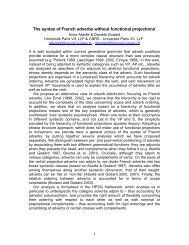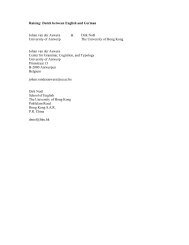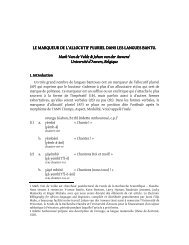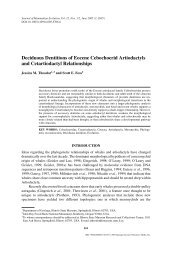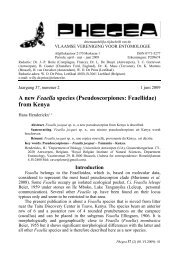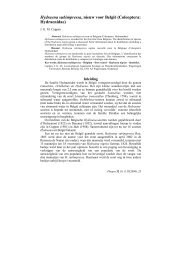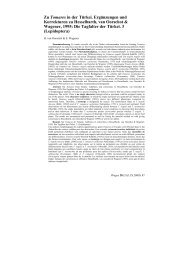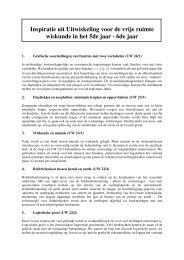Turtles as hopeful monsters
Turtles as hopeful monsters
Turtles as hopeful monsters
Create successful ePaper yourself
Turn your PDF publications into a flip-book with our unique Google optimized e-Paper software.
What the papers say<br />
<strong>Turtles</strong> <strong>as</strong> <strong>hopeful</strong> <strong>monsters</strong><br />
Olivier Rieppel<br />
Summary<br />
A recently published study on the development of the<br />
turtle shell (1) highlights the important role that development<br />
plays in the origin of evolutionary novelties (1) . The<br />
evolution of the highly derived adult anatomy of turtles is<br />
a prime example of a macroevolutionary event triggered<br />
by changes in early embryonic development. Early<br />
ontogenetic deviation may cause patterns of morphological<br />
change that are not compatible with scenarios<br />
of gradualistic, stepwise transformation. BioEssays<br />
23:987±991, 2001. ß 2001 John Wiley & Sons, Inc.<br />
Introduction<br />
<strong>Turtles</strong> are a very popular group of reptiles that have played an<br />
important role in the folklore and mythology of many cultures<br />
through the ages. Recently, turtles have gained new prominence<br />
in the study of amniote relationships and evolution.<br />
What makes turtles so special is their peculiar appearance.<br />
Their body is ``boxed in'' between the carapace that covers<br />
the back of the trunk, and the pl<strong>as</strong>tron, which covers the belly.<br />
The turtle shell is also referred to <strong>as</strong> dermal armor, in reference<br />
to the fact that the bones that make up the turtle shell ossify in<br />
the dermis, the deep layer of the skin.<br />
Department of Geology, The Field Museum, 1400 S Lake Shore Drive,<br />
Chicago, IL 60605-2496.<br />
Correspondence to: Olivier Rieppel, Department of Geology, The Field<br />
Museum, 1400 S Lake Shore Drive, Chicago, IL 60605-2496.<br />
E-mail: rieppel@fieldmuseum.org<br />
The turtle shell<br />
The capacity to form bone and other hard tissues such <strong>as</strong><br />
dentine and enamel in the skin, at the interface between the<br />
dermis and the superficial epidermis, w<strong>as</strong> realized in the<br />
earliest vertebrates, jawless fishes whose fossil record dates<br />
back some 450 Mio years. Well-known examples of dermal<br />
ossifications among modern animals are the bony scales of<br />
fishes, or the bony plates embedded in the skin of crocodiles<br />
and many lizards. Such bony plates, developing in the dermis,<br />
are referred to <strong>as</strong> osteoderms. The scales of fishes or the<br />
osteoderms of crocodiles and lizards, are always arranged in a<br />
single layer. In most turtles, the carapace also forms a single<br />
layer of bone, but there are some species in which the<br />
carapace consists of two superimposed sets of ossifications.<br />
This then requires the distinction of deeper thecal and<br />
superficial epithecal ossifications. (2±7) The thecal ossifications<br />
are always arranged in a very regular, strictly defined geometry<br />
that is closely comparable throughout turtles (Fig. 1A).<br />
A central longitudinal row of neural plates cap the neural<br />
spines of the dorsal vertebrae; a lateral row of costal plates is<br />
closely <strong>as</strong>sociated with the dorsal ribs (Fig. 2); a marginal row<br />
of marginal plates, an anterior nuchal plate, and one or two<br />
posterior pygal plate(s) complete the carapace. Epithecal<br />
ossifications are osteoderms that develop superficial to the<br />
thecal ossifications (Fig. 1B). Their appearance and arrangement<br />
varies among turtles.<br />
Early theories (2,8) attempted to explain the evolution of the<br />
turtle shell in the context of a step-wise, hence gradual process<br />
of transformation. The distant ancestor of turtles w<strong>as</strong><br />
hypothesized to have had a body loosely covered by<br />
osteoderms. Within the evolutionary lineage leading to turtles,<br />
the number of osteoderms would have gradually incre<strong>as</strong>ed,<br />
until the bony plates would eventually have provided a<br />
complete covering of the trunk, thus forming an epitheca.<br />
Thecal ossifications would have developed below the epitheca<br />
at later stages in the evolution of the turtle body<br />
plan, while epithecal ossifications would subsequently be<br />
lost at even more advanced stages of turtle evolution.<br />
This theory met with various difficulties, however, such <strong>as</strong><br />
the fact that the earliest fossil turtle (Proganochelys) (9) from<br />
the Upper Tri<strong>as</strong>sic of Europe (215 Mio years) h<strong>as</strong> a complete<br />
theca. Furthermore, epithecal ossifications appear later than<br />
ossifications of the theca in development and, in modern<br />
turtles, epithecal ossifications tend to form in evolutionarily<br />
relatively advanced forms only.<br />
The capacity to form dermal bone is certainly not a specialty<br />
of turtles, but their arrangement in a carapace and pl<strong>as</strong>tron<br />
is. <strong>Turtles</strong> are unique among tetrapods, however, in that<br />
the shoulder blade (scapula) lies inside the rib cage (Fig. 3).<br />
The re<strong>as</strong>on for this inverse relationship of the scapula is<br />
the close <strong>as</strong>sociation of the ribs with the costal plates of<br />
the theca.<br />
The development and evolution<br />
of the turtle shell<br />
In support of a gradual evolution of the turtle body plan, some<br />
authors tried to explain this position of the scapula by a<br />
backwards shift of the pectoral girdle in turtles. A recent theory<br />
proposed the evolution of turtles from Paleozoic Parei<strong>as</strong>aurs<br />
by a process of ``correlated progression''. (10) Correlated key<br />
elements of this progressive transformation are an incre<strong>as</strong>e in<br />
the number of osteoderms until they form a closed dorsal<br />
shield (carapace), the broadening of the ribs below this dorsal<br />
BioEssays 23:987±991, ß 2001 John Wiley & Sons, Inc. BioEssays 23.11 987
What the papers say<br />
Figure 1. Schematic representation of the turtle carapace in<br />
dorsal view (A) and in a transverse section (B) (A: after A.F.<br />
Carr, Handbook of <strong>Turtles</strong>, Cornell University Press, 1952,<br />
Fig. 2c).<br />
shield, the shortening of the trunk, the immobilization of the<br />
dorsal vertebral column and a backwards shift of the pectoral<br />
girdle.<br />
This evolutionary scenario (10) not only requires that the<br />
turtle carapace be derived from a fusion of ancestral osteoderms,<br />
but also encounters the problem that there is no, or only<br />
a very minor, backward shift of the pectoral girdle in turtles. (11)<br />
Instead, the scapula of turtles comes to lie inside the rib cage<br />
because of a deflection of rib growth to a more superficial<br />
position. (12) Recent developmental work (1,13,14) h<strong>as</strong> identified<br />
inductive interaction generated by the carapacial ridge <strong>as</strong><br />
probable cause of this deflection of rib growth. Here is how it<br />
works.<br />
The vertebrate embryo is organized in three germ layers,<br />
the outer ectoderm, the inner entoderm, and the mesoderm<br />
between the two. During development, that part of the<br />
mesoderm lying alongside the notochord (paraxial mesoderm)<br />
becomes compartmentalized into segments, discrete blocks<br />
of cells or somites. From the somites originate, by embryonic<br />
cell proliferation and migration, the endoskeleton, the voluntary<br />
body musculature, and the dermis, the deep layer of<br />
the skin. The somites define the primary segmentation of the<br />
vertebrate body, which in the adult is still reflected in the<br />
segmented body musculature of fishes or salamanders, for<br />
example. To bend the body into a lateral curve during<br />
locomotion, the segmented body muscles must bridge the<br />
intervertebral joint. This means that the joint between<br />
vertebrae must lie within the primary body segments, which<br />
also allows the spinal nerves to exit between two vertebrae on<br />
their way to the body muscles. By that arrangement, the<br />
vertebral body itself, and the rib attached to it, come to lie in<br />
between the primary body segments. This repositioning of the<br />
vertebrae relative to the primary body segments is achieved by<br />
resegmentation of the somites. Each somite splits in half, and<br />
the posterior part of one somite recombines with the anterior<br />
part of the succeeding somite to form a vertebra.<br />
As a turtle embryo grows and develops, the contours of the<br />
future carapace are soon mapped out by an accelerated<br />
growth and a thickening of the skin on its back. The carapacial<br />
disk is formed. The margin of the carapacial disk shares<br />
histological and chemical properties with the marginal apical<br />
ridge of the early limb bud, a region that w<strong>as</strong> long known to be<br />
an important site for inductive tissue interaction in the<br />
formation of the limb skeleton. Somite extirpation experiments<br />
confirmed a somitic origin for those cells that form the ribs <strong>as</strong><br />
well <strong>as</strong> the thickened dermis of the carapacial disk in the<br />
snapping turtle. (14) Extirpation experiments performed on<br />
the margin of the carapacial disk, referred to <strong>as</strong> carapacial<br />
ridge, confirmed its role in the deflection of rib growth to a more<br />
superficial position in turtles. (13)<br />
Exoskeleton versus endoskeleton<br />
By definition, the endoskeleton of vertebrates develops deep<br />
to the dermis of the skin, mostly preformed in cartilage that is<br />
later replaced by bone in a process called ossification. For<br />
most elements, ossification first forms a bony layer around the<br />
cartilage (perichondral bone), before bone replaces the<br />
degenerating cartilage inside the skeletal element (endochondral<br />
bone). All this is also true for most of the endoskeleton of<br />
turtles, but the ribs of turtles are unique among vertebrates in<br />
that they chondrify within the deep layers of the thickened<br />
dermis of the carapacial disk. Perichondral ossification starts<br />
at the point of entry of the rib into the dermis, and from there<br />
spreads laterally. Once the whole cartilage of the embryonic<br />
rib is surrounded by perichondral bone, trabecular bone starts<br />
to spread from the rib through the dermis of the carapacial disk,<br />
and the costal plate is formed. In a similar pattern, the<br />
cartilaginous tips of the neural spines of the dorsal vertebrae<br />
pierce the deep layers of the dermis of the carapacial disk.<br />
Following their perichondral ossification, trabecular bone<br />
988 BioEssays 23.11
What the papers say<br />
Figure 2. The carapace of a marine turtle (Caretta<br />
caretta) in ventral view, showing the close <strong>as</strong>sociation of<br />
the ribs with the costal plates.<br />
spreads from them through the dermis to form the neural<br />
plates.<br />
The unique pattern of development of the ribs at a level<br />
outside the shoulder blade is not the end of the story, however.<br />
The amniote vertebra is composed of two parts that originally<br />
develop independently, but most of the time fuse in the adult<br />
(Fig. 1B). One part is the centrum, which replaces the embryonic<br />
notochord. Above the centrum develops the neural arch,<br />
which together with the centrum forms the neural canal for the<br />
spinal cord. In turtles, the neural arches of the dorsal vertebrae<br />
shift forward by half a segment, carrying the ribs with them,<br />
again a unique condition in amniotes. (15) The neural arches of<br />
successive vertebrae consequently meet each other above<br />
the midpoint of the centrum, where<strong>as</strong> the ribs come to lie lateral<br />
to the no longer functional intervertebral joints. The myomeric<br />
and neuromeric segmentation is thus secondarily established<br />
in the dorsal region of turtles, (16) <strong>as</strong> w<strong>as</strong> already the c<strong>as</strong>e in<br />
Proganochelys. (9) The functional re<strong>as</strong>on for this anterior shift<br />
of the neural arches is not clear, other than that it may<br />
contribute to the mechanical strength of the carapace, <strong>as</strong> the<br />
neural plates come to alternate with the costal plates (Fig. 1A).<br />
The ossification of endoskeletal structures preformed in<br />
cartilage, such <strong>as</strong> the ribs, within the dermis poses special<br />
problems for the comparative anatomist. Three types of bone<br />
have cl<strong>as</strong>sically been recognized: dermal bone, which develops<br />
in the dermis and typically characterizes the exoskeleton,<br />
chondral bone, which replaces cartilage during ossification of<br />
the endoskeleton, and membrane bone, which ossifies in deep<br />
laying membranes <strong>as</strong> part of the endoskeleton without<br />
cartilaginous preformation. The costal and neural plates of<br />
the turtle carapace start to develop <strong>as</strong> perichondral bone, <strong>as</strong> is<br />
typical for the initial ph<strong>as</strong>e of ossification of endoskeletal<br />
elements. But this perichondral bone develops in the dermis,<br />
and from it trabecular bone spreads through the dermis during<br />
BioEssays 23.11 989
What the papers say<br />
Figure 3. The relationship of the shoulder blade to the carapace in turtles (Graptemys geographica).<br />
later developmental stages. In the turtle carapace, therefore,<br />
the distinction of endoskeleton versus exoskeleton becomes<br />
problematic. It had been recognized earlier that the endoskeleton<br />
versus exoskeleton cannot be distinguished on the b<strong>as</strong>is<br />
of histogenesis, but must be defined with reference to a<br />
phylogenetic framework. (17,18) Exoskeletal elements are<br />
homologous to structures that in the ancestral condition<br />
combine bone, dentine and enamel, i.e., develop at the<br />
ectoderm±mesoderm interface. Thus, the bony scales of a<br />
trout, or the osteoderms of a crocodile, are exoskeletal,<br />
because these are structures that ultimately can be traced<br />
back (are homologous) to the heavy scales of early fishes that<br />
combine bone, dentine and enamel in a three-layered scale.<br />
By contr<strong>as</strong>t, endoskeletal elements are elements that in the<br />
ancestral condition are preformed in cartilage, while the<br />
cartilaginous stage may be deleted in the descendant<br />
(membrane bone). In the turtle carapace, the neural and<br />
costal plates ossify from, and in continuity with, the periost of<br />
their endoskeletal component. This pattern of ossification<br />
corresponds to the definition of Zuwachsknochen, (18) i.e.,<br />
bone that complements an endoskeletal element that is itself<br />
preformed in cartilage. As such, neural and costal plates are<br />
endoskeletal components of the turtle carapace, and cannot<br />
be derived from a hypothetical ancestral condition by fusion of<br />
exoskeletal osteoderms. All other parts of the turtle carapace<br />
are exoskeletal, however.<br />
The origin of a new body plan<br />
The turtle body plan is evidently highly derived, indeed unique<br />
among tetrapods. The problem for an evolutionary biologist is<br />
to explain these transformations in the context of a gradualistic<br />
process. Given the recently obtained developmental evidence,<br />
(1,11,13) the theory of ``correlated progression'' (10) presents<br />
an incomplete explanation of the turtle body plan:<br />
formation of the carapace is not simply the consequence of a<br />
fusion of osteoderms, and the location of the scapula inside the<br />
rib cage is not the result of a backward migration of the pectoral<br />
girdle.<br />
Early in the 19th century, EÂ tienne Geoffroy Saint-Hilaire<br />
raised the question of how the lung of a reptile could be<br />
transformed into the lung of a bird? He found it impossible to<br />
postulate that the lung of a reptile, specialized in its own way,<br />
could transform into an even more specialized lung of a bird.<br />
But he recognized that both reptiles and birds share similar<br />
early embryonic rudiments of the lung, and he hypothesized<br />
that these could develop along different trajectories in the<br />
two groups due to a minor change in early ontogenetic<br />
development: ``It only required an `accident' [a change] that<br />
990 BioEssays 23.11
What the papers say<br />
is viable and of small magnitude in its origin, but which<br />
could be of unpredictable importance with respect to its<br />
effects''. (19)<br />
The same can be said with respect to the axial skeleton of<br />
turtles. The initial segmentation of the paraxial mesoderm is<br />
the same in turtles <strong>as</strong> in all other tetrapods, but further<br />
development of structures derived from the somites (dermis,<br />
vertebrae and ribs) proceeds along a different trajectory in<br />
turtles compared to all other tetrapods. Ribs can only be<br />
located either deep to, or superficial to, the scapula. There are<br />
no intermediates, and there is only one way to get from one<br />
condition to the other, which is the redirection of the migration,<br />
through the embryonic body, of the precursor cells that will<br />
form the ribs. The study of such complex problems <strong>as</strong> the<br />
evolution of the turtle body plan highlights the important role<br />
that development can play in the origin of evolutionary<br />
novelties.<br />
References<br />
1. Gilbert SF, Loredo GA, Brukman A, Burke AC. Morphogenesis of the<br />
turtle shell: the development of a novel structure in tetrapod evolution.<br />
Evol Dev 2001;3:47±58.<br />
2. Hay OP. On Protostega, the systematic position of Dermochelys, and the<br />
morphogeny of the chelonian carapace and pl<strong>as</strong>tron. Amer Nat<br />
1898;32:929±948.<br />
3. Kaelin J. Zur Morphogenese des Panzers bei den SchildkroÈten. Acta<br />
Anat 1945;1:144±176.<br />
4. ValleÂn E. BeitraÈge zur Kenntnis der Ontogenie und der vergleichenden<br />
Anatomie des SchildkroÈtenpanzers. Acta Zool Stockholm 1942;23:1±<br />
127.<br />
5. VoÈlker H. UÈ ber d<strong>as</strong> Stamm- Gliedm<strong>as</strong>sen-, und Hautskelett von<br />
Dermochelys coriacea L. Zool Jb Anat 1913;33:431±552.<br />
6. Zangerl R. The homology of the shell elements in turtles. J Morphol<br />
1939;65:383±406.<br />
7. Zangerl R. The turtle shell. In: Gans C, Bellairs Ad'A, Parsons TS, editors.<br />
Biology of the Reptilia Vol. 1, London: Academic Press; 1969.p. 311±<br />
339.<br />
8. Versluys J. UÈ ber die Phylogenie des Panzers der SchildkroÈten und uÈber<br />
die Verwandtschaft der LederschildkroÈte (Dermochelys coriacea).<br />
PalaÈont. Z 1914;1:321±347.<br />
9. Gaffney ES. The comparative osteology of the Tri<strong>as</strong>sic turtle Proganochelys.<br />
Bull. Amer Mus Nat Hist 1990;194:1±263.<br />
10. Lee MSY. Correlated progression and the origin of turtles. Nature<br />
1996;379:811±815.<br />
11. Burke AC. The development and evolution of the turtle body plan:<br />
inferring intrinsic <strong>as</strong>pects of the evolutionary process from experimental<br />
embryology. Amer Zool 1991;31:616±627.<br />
12. Ruckes H. Studies in chelonian osteology. Part II. The morphological<br />
relationships between girdles, ribs and carapace. Ann NY Acad Sci<br />
1929;31:81±120.<br />
13. Burke AC. Development of the turtle carapace: implications for the<br />
evolution of a novel bauplan. J. Morphol 1989;199:363±378.<br />
14. Yntema CL. Extirpation experiments on the embryonic rudiments of the<br />
carapace of Chelydra serpentina. J Morphol 1970;132:235±244.<br />
15. Goette A. UÈ ber die Entwicklung des knoÈchernen RuÈckenschildes<br />
(Carapax) der SchildkroÈten. Z wiss Zool 1899;66:407±434.<br />
16. Hoffstetter R, Rage J-C. Vertebrae and ribs of modern reptiles. In: Gans<br />
C, Bellairs Ad'A, Parsons TS, editors. Biology of the Reptilia Vol. 1<br />
London: Academic Press; 1969. p. 201±310.<br />
17. Patterson C. Cartilage bones, dermal bones and membrane bones, or<br />
the exoskeleton versus the endoskeleton. In: Andrews SM, Miles RS,<br />
Walker AD, editors. Problems in Vertebrate Evolution. London: Academic<br />
Press; 1977. p. 77±121.<br />
18. Starck D. Vergleichende Anatomie der Wirbeltiere auf evolutionsbiologischer<br />
Grundlage, Vol 2 Berlin: Springer Verlag; 1979.<br />
19. Geoffroy Saint-Hilaire E. Le deÂgre d'influence du monde ambiant pour<br />
modiifier les formes animales; question inteÂressant l'origine des espeÂces<br />
teÂleÂosauriennes et successivement celle des animaux de l'eÂpoque<br />
actuelle. MeÂm Acad R Sci Inst. France 1833;12:63±92. (The quote is<br />
from p. 80).<br />
BioEssays 23.11 991



